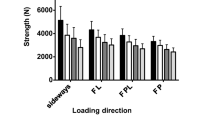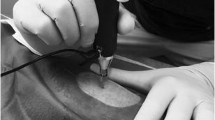Abstract
Summary
Periosteal expansion and bone loss have opposite effects on femur strength. Their combined effect has not been fully understood. Our investigation using a recently developed beam model suggested that periosteal expansion may maintain femur bending stiffness among elderly women, but not help preserve femoral strength and reduce hip fracture risk.
Introduction
Periosteal expansion and bone loss are two accompanying biological phenomena in old population. Their combined effect on bone stiffness, strength, and fracture risk is still not clear, because previous studies have reported contradictory results.
Methods
A recently developed DXA (dual-energy X-ray absorptiometry)-based beam model was applied to study the effect at the femoral neck. We first made a theoretical analysis. Then, a clinical cohort consisting of 961 women (316 hip fractures and 645 controls, age of 75.9 ± 7.1) was used to investigate the associations quantitatively. We investigated (1) correlations of femoral-neck width and bone mineral density with femoral stiffness and strength; (2) correlations of femoral stiffness, strength, and hip fracture risk index with age; (3) associations of femoral stiffness, strength and fracture risk index with actual fracture status, measured by the area under the curve (AUC) and odds ratio (OR).
Results
The investigation results showed that (i) femoral-neck width had stronger correlation with femoral bending stiffness (r = 0.61–0.82, p < 0.001) than with the other stiffness components, while bone mineral density had stronger correlation with axial/shearing stiffness (r = 0.84–0.97, p < 0.001), strength (r = 0.85–0.92, p < 0.001), and fracture risk index (r = −0.61–0.62, p < 0.001) than with bending stiffness. (ii) The association between femoral bending stiffness and age was insignificant (r = − 0.06–0.05, r > 0.05); The associations of axial/shearing stiffness (r = − 0.27–−0.20, p < 0.001), strength (r = − 0.28, p < 0.001), and fracture risk index (r = 0.38, p < 0.001) with age were significant. (iii) Fracture risk index had the strongest association with actual fracture status (AUC = 0.75, OR = 3.19), followed by strength (AUC = 0.74, OR = 2.84) and axial/shearing stiffness (AUC = 0.56–0.65, OR = 2.39–2.49). Femoral bending stiffness had the weakest association (AUC = 0.48–0.69, OR = 1.42–2.09).
Conclusion
We concluded that periosteal expansion may be adequate to maintain femoral bending stiffness among elderly women, but it may not help preserve strength and reduce hip fracture risk.

Similar content being viewed by others
References
Warming L, Hassager C, Christiansen C (2002) Changes in bone mineral density with age in men and women: a longitudinal study. Osteoporos Int 13:105–112
Finkelstein JS, Brockwell SE, Mehta V et al (2008) Bone mineral density changes during the menopause transition in a multiethnic cohort of women. J Clin Endocrinol Metab 93:861–868
Ahlborg HG, Johnell O, Turner CH, Rannevik G, Karlsson MK (2003) Bone loss and bone size after menopause. N Engl J Med 349:327–334
Birge SJ (1993) Osteoporosis and hip fracture. Clin Geriatr Med 9:69–86
Bliuc D, Nguyen ND, Alarkawi D, Nguyen TV, Eisman JA, Center JR (2015) Accelerated bone loss and increased post-fracture mortality in elderly women and men. Osteoporos Int 26:1331–1339
Huntjens KMB, Kosar S, van Geel TACM, Geusens PP, Willems P, Kessels A, Winkens B, Brink P, van Helden S (2010) Risk of subsequent fracture and mortality within 5 years after a non-vertebral fracture. Osteoporos Int 21:2075–2082
Bliuc D, Nguyen ND, Milch VE, Nguyen TV, Eisman JA, Center JR (2009) Mortality risk associated with low-trauma osteoporotic fracture and subsequent fracture in men and women. JAMA 301:513–521
Berger C, Langsetmo L, Joseph L et al (2008) Change in bone mineral density as a function of age in women and men and association with the use of antiresorptive agents. CMAJ 178:1660–1668
Brauer CA, Coca-Perraillon M, Cutler DM, Rosen AB (2009) Incidence and mortality of hip fractures in the United States. J Am Med Assoc 302:1573–1579
Kannus P, Parkkari J, Sievänen H, Heinonen A, Vuori I, Järvinen M (1996) Epidemiology of hip fractures. Bone 18(1 Suppl):57S–63S
Smith R, Walker R (1964) Femoral expansion in aging women: implications for osteoporosis and fractures. Science 217:945–948
Ruff CB, Hayes WC (1982) Subperiosteal expansion and cortical remodeling of the human femur and tibia with aging. Science 217:945–948
Loud KJ, Gordon CM (2006) Adolescent bone health. Arch Pediatr Adolesc Med 160:1026–1032
Davies JH, Evans BAJ, Gregory JW (2005) Bone mass acquisition in healthy children. Arch Dis Child 90:373–378
Schoenau E, Fricke O (2008) Mechanical influences on bone development in children. Eur J Endocrinol 159:S27–S31
Bergot C, Bousson V, Meunier A, Laval-Jeantet M, Laredo JD (2002) Hip fracture risk and proximal femur geometry from DXA scans. Osteoporos Int 13:542–550
McNabb BL, Vittinghoff E, Schwartz AV, Eastell R, Bauer DC, Ensrud K, Rosenberg E, Santora A, Barrett-Connor E, Black DM (2013) BMD changes and predictors of increased bone loss in postmenopausal women after a 5-year course of alendronate. J Bone Miner Res 28:1319–1327
Beck TJ, Ruff CB, Warden KE, Scott WWJ, Rao GU (1990) Predicting femoral neck strength from bone mineral data: a structural approach. Investig Radiol 25:6–18
Beck TJ (2007) Extending DXA beyond bone mineral density: understanding hip structure analysis. Curr Osteoporos Rep 5:49–55
Beck TJ, Looker AC, Mourtada F, Daphtary MM, Ruff CB (2006) Age trends in femur stresses from a simulated fall on the hip among men and women: evidence of homeostatic adaptation underlying the decline in hip BMD. J Bone Miner Res 21:1425–1432
Beck TJ, Ruff CB, Bissessur K (1993) Age-related changes in female femoral neck geometry: implications for bone strength. Calcif Tissue Int 53(Suppl 1):S41–S46
Jepsen KJ, Andarawis-Puri N (2012) The amount of periosteal apposition required to maintain bone strength during aging depends on adult bone morphology and tissue-modulus degradation rate. J Bone Miner Res 27:1916–1926, 2014
Milovanovic P, Adamu U, Simon MJK, Rolvien T, Djuric M, Amling M, Busse B (2015) Age- and sex-specific bone structure patterns portend bone fragility in radii and tibiae in relation to osteodensitometry: a high-resolution peripheral quantitative computed tomography study in 385 individuals. The Journals of Gerontology: Series A 70:1269–1275
Kozminski KJJ n A, Bigelow EMR, Schlecht SH, Goulet RW, Harlow SD, Cauley JA, Karvonen-Gutierrez C (2017) Femoral neck external size but not aBMD predicts structural and mass changes for women transitioning through menopause. J Bone Miner Res 32:1218–1228
Szulc P, Delmas PD (2007) Bone loss in elderly men: increased endosteal bone loss and stable periosteal apposition. The prospective MINOS study. Osteoporos Int 18:495–503
Gullberg B, Johnell O, Kanis JA (1997) World-wide projections for hip fracture. Osteoporos Int 7:407–413
Banks E, Reeves GK, Beral V, Balkwill A, Liu B, Roddam A (2009) Hip fracture incidence in relation to age, menopausal status, and age at menopause: prospective analysis. PLoS Med 6:e1000181
Piirtola M, Vahlberg T, Isoaho R, Aarnio P, Kivelä S-L (2007) Incidence of fractures and changes over time among the aged in a Finnish municipality: a population-based 12-year follow-up. Aging Clin Exp Res 19:269–276
Ensrud KE (2013) Epidemiology of fracture risk with advancing age. The Journals of Gerontology: Series A 68:1236–1242
Kanis JA (2002) Diagnosis of osteoporosis and assessment of fracture risk. Lancet 359:1929–1936
Luo Y, Yang H (2019) Assessment of hip fracture risk by cross-sectional strain-energy derived from DXA-based beam model. Clin Biomech 63:48–53
Luo Y, Sarvi MN, Sun P, Leslie W, Ouyang J (2014) Prediction of impact force in sideways fall of the elderly by DXA-based subject-specific dynamics modeling. International Biomechanics 1:1–14
Helgason B, Perilli E et al (2008) Mathematical relationships between bone density and mechanical properties: a literature review. Clin Biomech 23:135–146
Luo Y (2019) Empirical functions for conversion of femur areal and volumetric bone mineral density. Journal of Biomedical and Biological Engineering 39:287–293
Yang L, Peel N, Clowes JA, McCloskey EV, Eastell R (2009) Use of DXA-based structural engineering models of the proximal femur to discriminate hip fracture. J Bone Miner Res 24:33–42
Michelson JD, Myers A, Jinnah R, Cox Q, Van Natta M (1995) Epidemiology of hip fractures among the elderly: risk factors for fracture type. Clinical Orthopaedics & Related Research 311:129–135
Beck TJ, Looker AC, Ruff CB, Sievanen H, Wahner HW (2000) Structural trends in the aging femoral neck and proximal shaft: analysis of the Third National Health and Nutrition Examination Survey dual-energy X-ray absorptiometry data. J Bone Miner Res 15:2297–2304
Leslie WD, Luo Y, Yang S, Goertzen AL, Ahmed S, Delubac I, Lix LM (2019) Fracture risk indices from DXA-based finite element analysis predict incident fractures independently from FRAX: the Manitoba BMD registry. J Clin Densitom 22:338–345
S. Timoshenko and J.N. Goodier. (1951) Theory of elasticity. McGraw-Hill Book Company, Inc.,New York.
Kaptoge S, Beck TJ, Reeve J et al (2008) Prediction of incident hip fracture risk by femur geometry variables measured by hip structural analysis in the study of osteoporotic fractures. J Bone Miner Res 23:1892–1904
Ahlborg HG, Nguyen ND, Nguyen TV, Center JR, Eisman JA (2005) Contribution of hip strength indices to hip fracture risk in elderly men and women. J Bone Miner Res 20:1820–1827
Gale CR, Cooper C, Sayer AA (2016) Prevalence and risk factors for falls in older men and women: the English Longitudinal Study of Ageing. Age Ageing 45:789–794
Al-Aama T (2011) Falls in the elderly. Can Fam Physician 57:771–776
Durosier C, Hans D, Krieg MA, Schott AM (2006) Prediction and discrimination of osteoporotic hip fracture in postmenopausal women. J Clin Densitom 9:475–495
Nguyen TV, Center JR, Eisman JA (2013) Individualized fracture risk assessment: progresses and challenges. Curr Opin Rheumatol 25:532–541
Luo Y (2016) A biomechanical sorting of clinical risk factors affecting osteoporotic hip fracture. Osteoporos Int 27:423–439
Boskey AL, Coleman R (2010) Aging and bone. J Dent Res 89:1333–1348
Nawathe S, Yang H, Fields AJ, Bouxsein ML, Keaveny TM (2015) Theoretical effects of fully ductile versus fully brittle behaviors of bone tissue on the strength of the human proximal femur and vertebral body. J Biomech 48:1264–1269
Acknowledgments
The research reported in this paper has been supported by Research Manitoba and the Natural Science and Engineering Research Council of Canada, which are gratefully acknowledged. Thanks to St. Boniface General Hospital in Winnipeg for providing the clinical cohort and DXA images used in this study.
Author information
Authors and Affiliations
Corresponding author
Ethics declarations
Conflicts of interest
None.
Additional information
Publisher’s note
Springer Nature remains neutral with regard to jurisdictional claims in published maps and institutional affiliations.
Electronic supplementary material
ESM 1
(PPTX 207 kb)
Rights and permissions
About this article
Cite this article
Luo, Y. Age-related periosteal expansion at femoral neck among elderly women may maintain bending stiffness, but not femoral strength. Osteoporos Int 31, 371–377 (2020). https://doi.org/10.1007/s00198-019-05165-6
Received:
Accepted:
Published:
Issue Date:
DOI: https://doi.org/10.1007/s00198-019-05165-6




